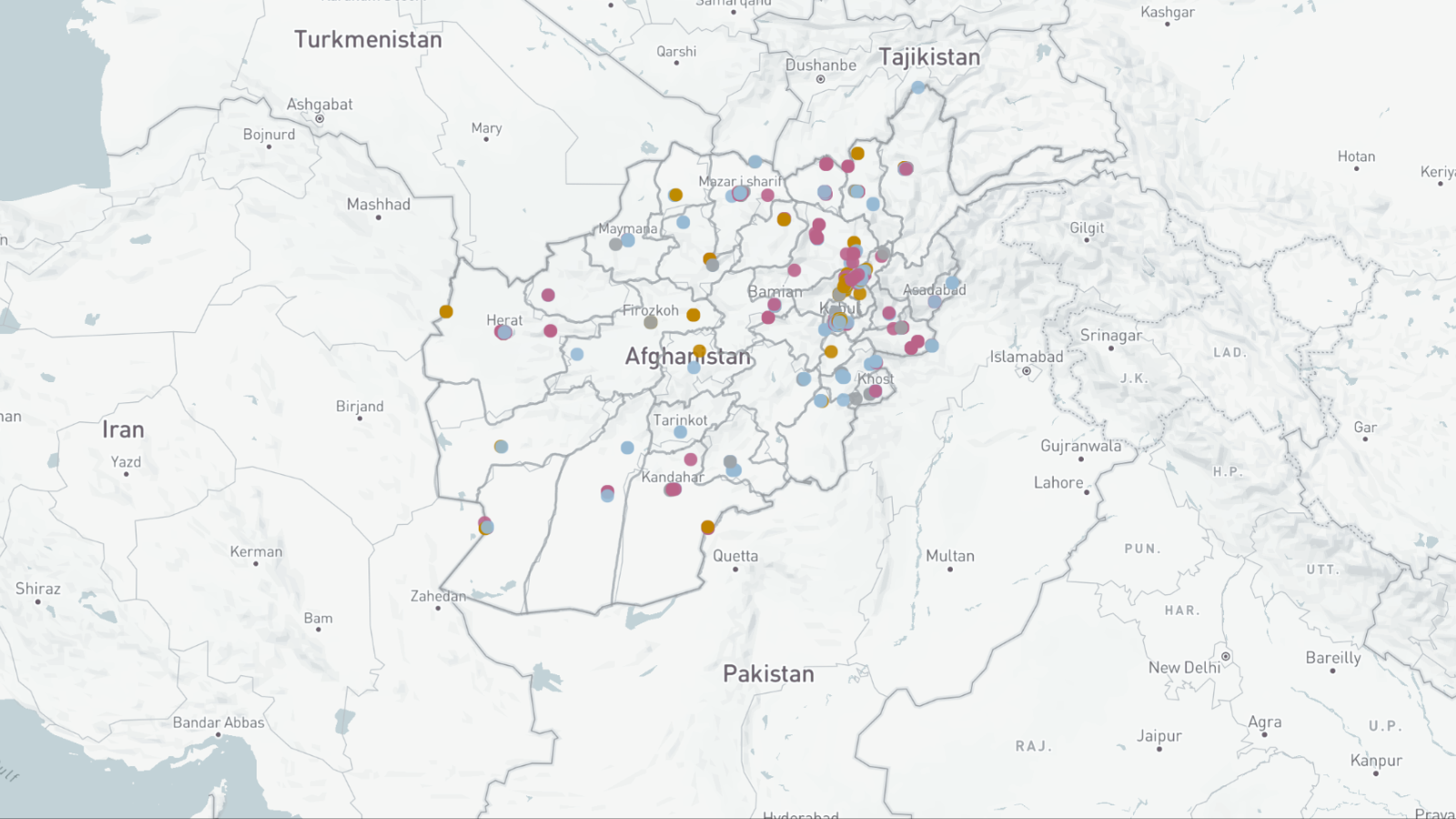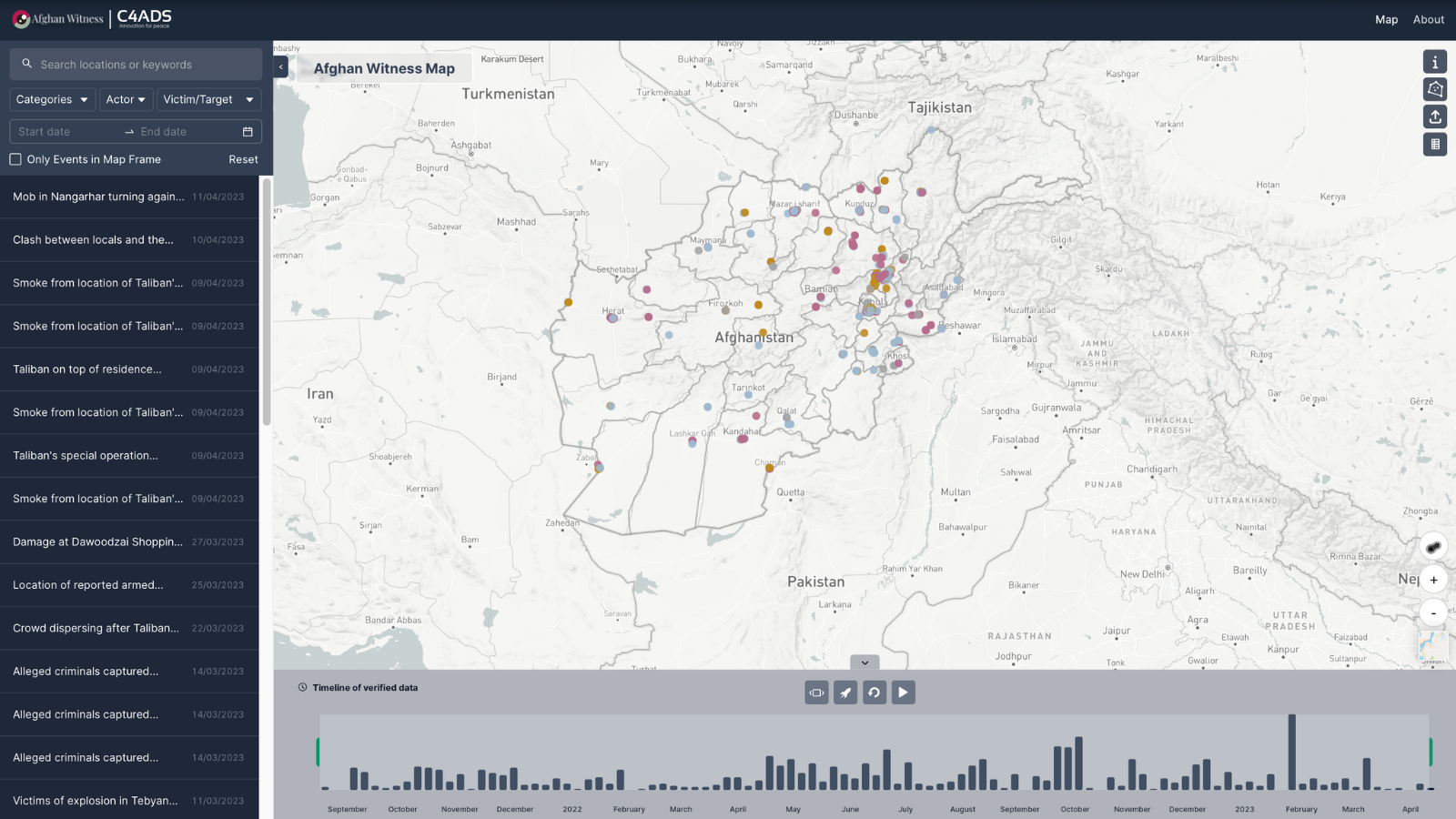 The new Afghan Witness map, built in partnership with C4ADS.
The new Afghan Witness map, built in partnership with C4ADS.
Since the fall of Kabul in August 2021, the Taliban’s restrictions on media have left journalists increasingly limited in their ability to report independently, particularly when it comes to investigating human rights abuses. While social media has been essential for circulating information and raising awareness of the situation in Afghanistan, misinformation poses an increasing threat to the country’s information environment, hindering the efforts of international organisations and journalists, as well as ordinary citizens, to source reliable, up-to-date information.
Today, the Centre for Information Resilience’s (CIR) Afghan Witness project releases a live map that documents verified evidence of human rights abuses in Afghanistan. Built in partnership with US-based non-profit C4ADS, the map records open source data of abuses, security incidents and protests since the Taliban’s takeover of Afghanistan. It enables journalists, researchers, policymakers and the public to visualise the extent of human rights violations in the country. The map design and functionality have been based on CIR’s Eyes on Russia map, also built by C4ADS.
David Osborn, Afghan Witness’ team leader, said:
“Open source allows us to monitor and investigate human rights issues throughout Afghanistan which is particularly important as journalists – local and international – are limited in their ability to report independently.
“Different individuals and armed groups are perpetrating human rights abuses in Afghanistan today. Afghan Witness investigates, verifies where possible and archives data in the hope that one day accountability mechanisms will bring the perpetrators to justice.”
Since the project began in October 2021, the Afghan Witness team have been continually monitoring social media and digital platforms to collect user-generated content such as images and video footage, as well as satellite imagery, news reports and written statements from the Taliban authorities. For the first time, this database is now publicly available for audiences to interact with in the form of the Afghan Witness map.
 Data can be searched and filtered by incident category, actor, and victim/target using the side pane, and is also displayed in a timeline beneath the map.
Data can be searched and filtered by incident category, actor, and victim/target using the side pane, and is also displayed in a timeline beneath the map.
The map contains more than 1300 data points of incidents that have occurred since 17 August 2021. It reveals ongoing human rights abuses of civilians, journalists and ethnic minorities, as well as the evolution of the Afghan women’s rights protest movement and attacks by militants and terrorist groups.
Data contained in the map can be filtered by category, date, perpetrator and victim/target. The map will be regularly updated but currently documents more than 450 pieces of footage showing attacks on civilians, more than 350 pieces of footage of protests and more than 100 items showing attacks on Shia and Hazara communities.
While the Afghan Witness team monitors information emerging from Afghanistan on a daily basis, only verifiable data makes it onto the map. This includes user-generated content that can be analysed or geolocated, or claims that have been triangulated against other sources. As with CIR’s other projects, Afghan Witness securely stores and hashes evidence of human rights violations in case it is one day used to hold perpetrators to account.
While claims of violations are widespread, analysts are only able to investigate visual evidence that emerges online or is uploaded anonymously via the Afghan Witness website. Therefore, the data visible on the map represents only the tip of the iceberg when it comes to human rights violations in Afghanistan, with self-censorship a likely factor limiting information from surfacing.
The release of the Afghan Witness map is timely given the growing recognition of open source techniques as a means of verifying information and investigating human rights abuses. It demonstrates the utility of open source methods to remotely monitor the situation in Afghanistan at a time when the international press has limited access to the country and domestic news outlets face restrictions on press freedom. Crucially, the verified data recorded on the map helps paint a picture of the reality of life for Afghans living in the country.
“Our ability to tell the stories of the Taliban’s human rights abuses through visualisation is a powerful tool,” said Lawrence Henderson, Conflict Affected States Program Director at C4ADS.
“Technology can provide a means of accountability on behalf of those innocent Afghans who live under the Taliban’s repression today. Be it in Afghanistan or Ukraine, we hope that our innovative approach to showcasing these acts of violence puts the perpetrators on notice and sends a message that the world is watching.”
The Afghan Witness map will increase access to reliable information on Afghanistan, but it will also promote awareness of how transparent methods of data verification are vital for strengthening the country’s information environment and restoring trust in information.
Afghan Witness’ monitoring of social media platforms has flagged a rapid erosion of Afghanistan’s information environment. Misinformation is widespread, with images and videos regularly shared out of context or old material repurposed. While these posts are not always malicious, analysts have also identified more deliberate attempts to deceive – such as pro-Taliban false news accounts mimicking genuine news outlets and spreading disinformation to undermine opposition groups.
“Afghan Witness has seen a catastrophic erosion in the quality of factual information in Afghanistan. Rumours, mistaken false claims and deliberate campaigns of deception are rife,” said Afghan Witness’ Osborn.
“Everyone suffers when no one believes what is in the news or on social media. Open source data and verifying information is one way of rebuilding trust and tackling inaccurate or misrepresented information.”
In recent months, Afghan Witness has been working with Afghan organisations to build capabilities for open source research and verification. This includes training sessions which aim to equip and empower organisations with tools they can employ in their daily work, while also increasing awareness of how to identify mis- and disinformation in a world where fact and fiction are becoming increasingly difficult to distinguish between.
You can view the Afghan Witness map at https://www.afghanwitness.org/map, where you can also find more information about Afghan Witness, as well as a range of the project’s in-depth reports. Specific enquiries can be emailed to the team via [email protected]
